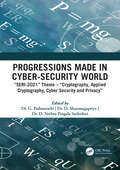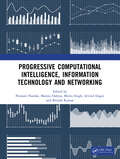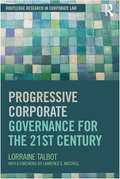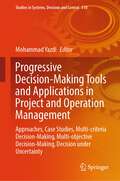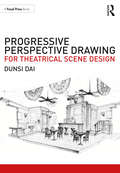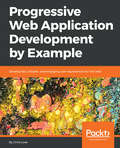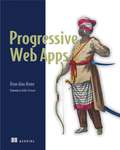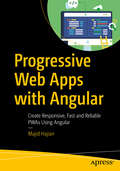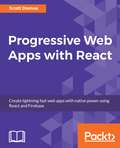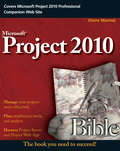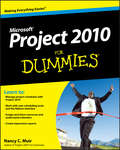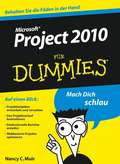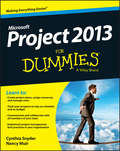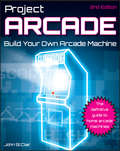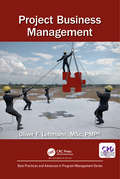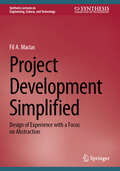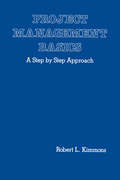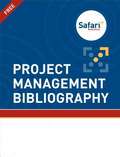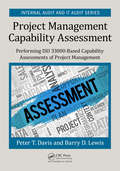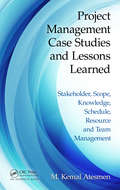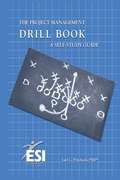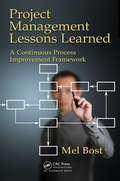- Table View
- List View
Progressions made in Cyber-Security World: SERI-2021 Theme – Cryptography, Applied Cryptography, Cyber Security and Privacy
by Dr G. PadmavathiSERI-2021 was a success with the presence of our valuable Guest Speakers who lead the discussion in various session in just the right direction showering the audiences with their esteemed valuable knowledge and insights in the field.The various sessions we had such as "Quad: Cyber security capabilities", "National Interventions and Programs for Security Education", "Cyber First: This and next generation", "Crypto: Releasing possibilities" etc.not only focussed on the present scenario but also defined the futuristic scope of in the filed of cyber-security.The Conference had an interesting competition judged by the top scholarly of cyber-security field as Paper-Presentation which saw number of entries and few finally making it to the top.This book has the top 3 papers presented.Hope you will enjoy surfing through new interventions in the field.
Progressive Computational Intelligence, Information Technology and Networking
by Brijesh Kumar Arvind Dagur Mamta Dahiya Poonam Nandal Meeta SinghProgressive Computational Intelligence, Information Technology and Networking presents a rich and diverse collection of cutting-edge research, real-world applications, and innovative methodologies spanning across multiple domains of computer science, artificial intelligence, and emerging technologies. This comprehensive volume brings together different scholarly chapters contributed by researchers, practitioners, and thought leaders from around the globe.The book explores a wide array of topics including—but not limited to—machine learning, deep learning, cloud computing, cybersecurity, Internet of Things (IoT), blockchain, natural language processing, image processing, and data analytics. It addresses the practical implementation of technologies in sectors such as healthcare, agriculture, education, smart cities, environmental monitoring, finance, and more.Each chapter delves into specific challenges, frameworks, and experimental outcomes, making this book an essential reference for academicians, researchers, industry professionals, and students who aim to stay ahead in the rapidly evolving digital world.
Progressive Corporate Governance for the 21st Century (Routledge Research in Corporate Law)
by Lorraine TalbotProgressive Corporate Governance for the 21st Century is a wide ranging and ambitious study of why corporate governance is the shape that it is, and how it can be better. The book sets out the emergence of shareholder primacy orientated corporate governance using a study of historical developments in the United Kingdom and the United States. Talbot sees shareholder primacy as a political choice made by governments, not a ‘natural’ feature of the inevitable market. She describes the periods of progressive corporate governance which governments promoted in the middle of the 20th century using a close examination of the theories of the company which then prevailed. She critically examines the rise of neoliberal theories on the company and corporate governance and argues that they have had a negative and regressive impact on social and economic development. In examining contemporary corporate governance she shows how regulatory styles as informed and described by prevailing regulatory theories, enables neoliberal outcomes. She illustrates how United Kingdom-derived corporate governance codes have informed the corporate governance initiatives of European and global institutions. From this she argues that neoliberalism has re-entered ex command transition economies through those United Kingdom and OECD inspired corporate governance Codes over a decade after the earlier failed and destructive neoliberal prescriptions for transition had been rejected. Throughout, Talbot argues that shareholder primacy has socially regressive outcomes and firmly takes a stand against current initiatives to enhance shareholder voting in such issues as director remuneration. The book concludes with a series of proposals to recalibrate the power between those involved in company activity; shareholders, directors and employees so that the public company can begin to work for the public and not shareholders.
Progressive Decision-Making Tools and Applications in Project and Operation Management: Approaches, Case Studies, Multi-criteria Decision-Making, Multi-objective Decision-Making, Decision under Uncertainty (Studies in Systems, Decision and Control #518)
by Mohammad YazdiIn today's complex operational environments, leveraging advanced decision-making tools becomes imperative, particularly in uncertain scenarios. This book deepens the nuances of employing state-of-the-art decision-making methodologies within various industrial sectors for optimal project and operations management. The essence of integrating these advanced tools is to equip professionals with pivotal insights for cost-effective management and to strategize against potential operational shortcomings. Furthermore, the methodologies elucidated provide a robust foundation for crafting informed, risk-centric strategies that uphold the integrity of operations across diverse application domains. Readers will discover a rich tapestry of methodologies tailored for engineers and analysts. Deeply rooted in mathematical modeling, these approaches are complemented by human judgment and participation. Fundamental attributes of these methods include the evaluation of alternatives, benchmarking againstcriteria, assigning scores based on varying requirements, and assigning weights to denote the significance of individual criteria vis-à-vis others. The book embarks on a structured journey, commencing with a comprehensive review of evolving decision-making methodologies in project and operations management, enriched by metadata analysis. Subsequent chapters are meticulously organized, each spotlighting a distinct approach. Topics span foundational concepts in decision-making, the nuances of performance metrics in the digital age, and the implications of emerging technologies on operations management. Targeted towards professionals and researchers immersed in project and operations management, this work will also immensely benefit postgraduate and undergraduate students in related fields. Moreover, its relevance extends to professionals across diverse sectors, from oil and gas, marine and offshore, and renewable energies to chemical complexes, manufacturing, and healthcare systems.
Progressive Perspective Drawing for Theatrical Scene Design
by Dunsi DaiProgressive Perspective Drawing for Theatrical Scene Design provides theatrical scenic designers with the tools to create quick and precise perspective drawings. The book explores three methods of perspective drawings at progressive skill levels – the Grid Method, the Frame Method, and the Freehand with References Method – allowing scenic designers to build on their drawing technique consistently. Replete with discussions on pencil techniques, step by step instructions, and set sketches from professional set design projects, this volume guides readers from the basics of the cube system to the more challenging freehand drawing. Progressive Perspective Drawing for Theatrical Scene Design is an excellent resource for students of Scene Design, Stage Design, Set Design, Scenography, Stagecraft, and Design for Theatre, as well as an accessible self-study guide for those with an interest in scene design. The book includes access to downloadable pre-made perspective grids, to help readers familiarize themselves with one and two vanishing point grids.
Progressive Web Application Development by Example: Develop fast, reliable, and engaging user experiences for the web
by Chris LoveLeverage the full potential of the web to make your web sites better than native applications for every platform. Key FeaturesExplore different models and patterns required to develop progressive web applicationsCreate applications requiring shorter runtime for attracting more usersStudy different projects to understand the fundamentals of progressive web applicationsBook DescriptionAre you a developer that wants to create truly cross-platform user experiences with a minimal footprint, free of store restrictions and features customers want? Then you need to get to grips with Progressive Web Applications (PWAs), a perfect amalgamation of web and mobile applications with a blazing-fast response time.Progressive Web Application Development by Example helps you explore concepts of the PWA development by enabling you to develop three projects, starting with a 2048 game. In this game, you will review parts of a web manifest file and understand how a browser uses properties to define the home screen experience. You will then move on to learning how to develop and use a podcast client and be introduced to service workers. The application will demonstrate how service workers are registered and updated. In addition to this, you will review a caching API so that you have a firm understanding of how to use the cache within a service worker, and you'll discover core caching strategies and how to code them within a service worker.Finally, you will study how to build a tickets application, wherein you’ll apply advanced service worker techniques, such as cache invalidation. Also, you'll learn about tools you can use to validate your applications and scaffold them for quality and consistency. By the end of the book, you will have walked through browser developer tools, node modules, and online tools for creating high-quality PWAs.What you will learnExplore the core principles of PWAs Study the three main technical requirements of PWAs Discover enhancing requirements to make PWAs transcend native apps and traditional websites Create and install PWAs on common websites with a given HTTPS as the core requirementGet acquainted with the service worker life cycle Define service worker caching patternsApply caching strategies to three different website scenariosImplement best practices for web performanceWho this book is forProgressive Web Application Development by Example is for you if you’re a web developer or front-end designer who wants to ensure improved user experiences. If you are an application developer with knowledge of HTML, CSS, and JavaScript, this book will help you enhance your skills in order to develop progressive web applications, the future of app development.
Progressive Web Apps
by Dean HumeSummaryProgressive Web Apps teaches you PWA design and the skills you need to build fast, reliable websites by taking you step-by-step through real world examples in this practical tutorial. Foreword by Addy Osmani, Google.Purchase of the print book includes a free eBook in PDF, Kindle, and ePub formats from Manning Publications.About the TechnologyOffline websites that work. Near-instant load times. Smooth transitions between high/low/no bandwidth. Fantasy, right? Not with progressive web applications. PWAs use modern browser features like push notifications, smart caching, and Service Workers to manage data, minimize server usage, and allow for unstable connections, giving you better control and happier customers. Better still, all you need to build PWAs are JavaScript, HTML, and the easy-to-master techniques you'll find in this book.About the BookProgressive Web Apps teaches you PWA design and the skills you need to build fast, reliable websites. There are lots of ways you can use PWA techniques, and this practical tutorial presents interesting, standalone examples so you can jump to the parts that interest you most. You'll discover how Web Service Workers vastly improve site loading, how to effectively use push notifications, and how to create sites with a no-compromise offline mode. What's InsideImproved caching with Service WorkersUsing manifest files and HTML markupPush notificationsOffline-first web designsTechniques for data synchronizationAbout the ReaderWritten for readers with experience developing websites using HTML, CSS, and JavaScript.About the AuthorDean Alan Hume is a coder, author, and Google Developer Expert. He's passionate about web performance and user experience.Table of ContentsPART 1 - DEFINING PROGRESSIVE WEB APPS Understanding Progressive Web Apps First steps to building a Progressive Web App PART 2 - FASTER WEB APPS Caching Intercepting network requests PART 3 - ENGAGING WEB APPS Look and feel Push notifications PART 4 - RESILIENT WEB APPLICATIONS Offline browsing Building more resilient applications Keeping your data synchronized PART 5 - THE FUTURE OF PROGRESSIVE WEB APPSStreaming data Progressive Web App troubleshooting The future is looking good
Progressive Web Apps with Angular: Create Responsive, Fast and Reliable PWAs Using Angular
by Majid HajianHarness the power of Angular to build fast, high performance progressive web apps that work offline. Learn exactly how to create an Angular Progressive Web App (PWA) from scratch, how you can use different tools to audit and improve it, and leverage Angular CLI or Workbox to turn your app into a PWA. Using browser APIs – including the Credential Management, Payment Request, Geolocation, Web Bluetooth, WebUSB and Generic Sensors APIs – you can unleash the potential of PWAs and build applications that enhance user experience. Angular’s game-changing built-in features, including the Angular service worker module, can be leveraged to construct responsive and reliable PWAs that can look and feel just like native mobile apps. You'll learn how to boost your app speed, how to increase user engagement using push notifications, and how to implement offline storage and different caching APIs in Angular. You'll even see how to convert an existing Angular app into a PWA. Whether you’re new to building PWAs, or want to learn how to use Angular to improve your app development, Progressive Web Apps with Angular provides the know-how to build and deploy an Angular PWA.What Readers Will LearnBuild an Angular app that looks and feels just like a native mobile appAudit and improve an Angular PWA with different toolsIncrease user engagement by using push notificationsOffline storage and different caching APIs in AngularImplement modern technologies into an Angular PWAWho This Book Is For Developers with basic knowledge of HTML, JavaScript and Angular
Progressive Web Apps with React: Create lightning fast web apps with native power using React and Firebase
by Scott DomesEnhance the performance of your applications by using React and adding the Progressive web app capability to itAbout This BookBring the best of mobile sites and native apps to your users with progressive web applicationsCreate fast, reliable, and engaging PWAs with React and FirebaseCreate high-performance applications even with low connection speeds by leveraging modern web technologiesWho This Book Is ForThis book is for Javascript Developers who want to develop high performance Web User Interfaces. This book requires basic knowledge of HTML, CSS and JavaScript.What You Will LearnSet up Webpack configuration, as well as get the development server runningLearn basic Firebase configuration and deploymentCreate routes, manage multiple components, and learn how to use React Router v4 to manage the flow of dataUse React life cycle methods to load dataAdd a service worker to the app and learn how it worksUse a service worker to send Push NotificationsConfigure Webpack to split up the JavaScript bundle and lazy load component filesLearn how to use the web Cache API to use your app offlineAudit PWAs with Google's Lighthouse toolIn DetailFor years, the speed and power of web apps has lagged behind native applications. Progressive Web Apps (PWAs) aim to solve this by bridging the gap between the web apps and native apps, delivering a host of exciting features. Simultaneously, React is fast becoming the go-to solution for building modern web UIs, combining ease of development with performance and capability. Using React alongside PWA technology will make it easy for you to build a fast, beautiful, and functional web app.After an introduction and brief overview of the goals of PWAs, the book moves on to setting up the application structure. From there, it covers the Webpack build process and the process of creating React components. You'll learn how to set up the backend database and authentication solution to communicate with Firebase and how to work with React Router. Next, you will create and configure your web app manifest, making your PWA installable on mobile devices. Then you'll get introduced to service workers and see how they work as we configure the app to send push notifications using Firebase Cloud Messaging. We'll also explore the App Shell pattern, a key concept in PWAs and look at its advantages regarding efficient performance. Finally, you'll learn how to add offline capabilities to the app with caching and confirm your progress by auditing your PWA with Lighthouse. Also, you'll discover helper libraries and shortcuts that will help you save time and understand the future of PWA development.Style and approachThis is a step-by-step book, wherein, you will use the React framework to create a complete progressive web app.
Progressive and Integrative Ideas and Applications of Engineering Systems Under the Framework of IOT and AI: Proceedings of 2nd International Conference on Intelligent Systems Design and Engineering Applications (Lecture Notes in Electrical Engineering #1076)
by Yongsheng MaThis volume of proceedings contains peer reviewed papers presented at 2023 International Conference on Intelligent Systems Design and Engineering Applications which was held in Okayama, Japan, May 12-14, 2023 (ISDEA2023). There are five major sessions covered in this book, including 1) Theory and Application of Artificial Intelligence Technologies in Industry; 2) System Design and Data Analysis within the Context of Internet of Things (IOT) ; 3) System Automation, Control, and Robots; 4) Smart Product Design and Integrated Manufacturing and 5) Sensors, Transducers and detection technology. This conference provides an idea-exchange and discussion platform for the world's engineers and academia to share cutting-edge information, address the hottest issue in intelligent systems design and engineering applications, explore new technologies, exchange and build upon ideas.
Project 2010 Bible
by Elaine MarmelA comprehensive reference on the latest version of the leading enterprise project management software: Microsoft Project 2010 Microsoft Project allows users to manage business activities effectively by sharing project information, performing modeling and scenario analyses, standardizizing reporting processes, and more. This soup-to-nuts reference covers both the professional and standard versions of the latest iteration of Microsoft Project, as well as Project Server, so that you can efficiently manage your business projects. Veteran author Elaine Marmel begins with an overview of project management basics and then gradually moves on to more advanced topics so that you can learn the scope of what successful project management entails. Popular author Elaine Marmel provides comprehensive coverage of Microsoft Project 2010 and shows you how to successfully manage your business activities Begins with project management basics, such as creating a new project, tracking a project's progress, and working in groups Covers more advanced topics, including customizing Project, using macros, and importing and exporting information Demonstrates how to build tasks, use views, modify the appearance of a project, and resolve scheduling and resource problems With Project 2010 Bible by your side, you'll learn to confidently and skillfully put Microsoft Project 2010 to work for you.
Project 2010 For Dummies
by Nancy C. MuirA friendly reference guide to Microsoft Project, the leading enterprise project management softwareAs project management software, Microsoft Project allows you to oversee your business activities effectively. You can manage resources, share project info, perform modeling and scenario analysis, and standardize reporting processes. This easy-to-understand guide is completely updated to cover the latest changes and newest enhancements to Project 2010 and shows you how to get Project 2010 to work for you.After an introduction to basic project management concepts, you'll discover the mechanics of using Project software to create and manage projects. Other topics covered include working with calendars, using and sharing resources, budgeting, formatting taskbars, gathering and tracking data, working with reports, and creating templates.Microsoft Project allows you to manage resources, share project information, perform scenario analysis, and standardize reporting processesOffers completely updated coverage of the new Project 2010, which is expected to implement the Office RibbonReviews formatting taskbars, gathering and tracking data, and working with reportsAddresses using and sharing resources, creating templates, and managing projectsLet the friendly For Dummies writing style guide you through maximizing the new features of Project 2010.
Project 2010 Project Management
by Robert HappyThe ideal on-the-job reference guide for project managers who use Microsoft Project 2010This must-have guide to using Microsoft Project 2010 is written from a real project manager's perspective and is packed with information you can use on the job. The book explores using Project 2010 during phases of project management, reveals best practices, and walks you through project flow from planning through tracking to closure. This valuable book follows the processes defined in the PMBOK Guide, Fourth Edition, and also provides exam prep for Microsoft's MCTS: Project 2010 certification.Explains Microsoft Project 2010, the leading software tool for project managersShows working project managers practical ways to use Project 2010 on the jobDelves into project planning, tracking, reporting, and project closure, and explores best practices for all phases of planningReveals new software features, including tools that show what factors are affecting the schedule, a "what-if" scenario builder, and how slippages affect other aspects of the projectFollows processes and procedures from The Guide to Project Management Body of Knowledge (PMBOK), Fourth EditionCovers the skill set required for the MCTS: Microsoft Project 2010, Managing Projects certification, so you can use this book for exam prep This valuable book follows the processes defined in the PMBOK Guide, Fourth Edition, and also provides exam prep for Microsoft's MCTS: Project 2010, Managing Projects certification.Note: CD-ROM/DVD and other supplementary materials are not included as part of eBook file.
Project 2010 für Dummies (Für Dummies)
by Nancy C. MuirWer sich selbst und seine Projekte gut organisieren kann, hat immer gute Karten. Alle, die MS Project 2010 einsetzen und damit jede Menge Zeit sparen wollen, ist dieses Buch genau das Richtige. Natürlich bleibt das Buch trotz des ernsten und anspruchsvollen Themas dem Dummiesstil treu und führt locker und amüsant durch die Möglichkeiten dieses Programms. Sie erfahren, was neu ist bei MS Project 2010, wie sie viel Zeit und Nerven sparen können, wie man MS Project und MS Office zusammenarbeiten lässt und vieles mehr, das man braucht, um dieses Programm erfolgreich und kreativ zu nutzen.
Project 2013 For Dummies
by Cynthia Stackpole SnyderAn easy-to-understand guide to the?latest version of Microsoft's enterprise project management software: Project 2013If you've never used project management software before?or if?you're just getting up to speed on the new features in Project 2013, this is the book for you! With this easy-to-understand guide, you have a completely updated resource that covers the latest changes and newest enhancements to Project 2013 and shows you how to?make Project 2013 work for you. After an introduction to basic project management concepts, you'll discover the mechanics of using Project software to create and manage projects. Other topics covered include working with calendars, using and sharing resources, budgeting, formatting taskbars, gathering and tracking data, working with reports, and creating templates.Shows you how to manage resources, share project information, perform scenario analysis, and standardize reporting processesPresents completely updated coverage of the new Project 2013Reviews formatting taskbars, gathering and tracking data, and working with reportsAddresses using and sharing resources, creating templates, and managing projectsTake charge of your next project and ensure its success with a little help from Project 2013 For Dummies.
Project Arcade
by John St. ClairThe bestseller returns--completely updated to include the newest hardware, software, and techniques for building your own arcadeInterest in classical arcade games remains on the rise, and with a little money, older computer hardware, and a little effort, you can relive your arcade experiences by building your own arcade machine. The hands-on guide begins with a description of the various types of projects that you can undertake. It then progresses to a review of the audio and video options that are available and looks at the selection of game software and cabinet artwork. Ultimately, you'll learn essential troubleshooting tips and discover how to build arcade controllers and machines that you can enjoy at home with your PC.Serves as a soup-to-nuts guide for building your own arcade machine, from the sheets of wood to the finished productAddresses the variety of arcade controls, including joysticks, buttons, spinners, trackballs, flight yokes, and gunsExplains how to interface arcade controls to a computerShares troubleshooting tips as well as online resources for help and inspirationProject Arcade, Second Edition helps you recapture the enjoyment of your youth that was spent playing arcade games by walking you through the exciting endeavor of building your own full arcade machine.
Project Business Management (Best Practices in Portfolio, Program, and Project Management)
by Oliver F. LehmannRoughly half of all project managers have to lead customer projects as profit centers on contractor side with two big objectives: making the customer happy and bringing money home. Customer projects are a high-risk business on both sides, customers and contractors, but the dynamics of this business have so far been mostly ignored in literature. The book is intended to fill this gap. The book helps project managers better understand the dynamics of customer projects under contract from business development through handover and find solutions for common problems. A central aspect is international contract laws, an often underestimated factor in projects.
Project Development Simplified: Design of Experience with a Focus on Abstraction (Synthesis Lectures on Engineering, Science, and Technology)
by Fil A. MaciasThis book explains and outlines the use of hierarchical abstraction for project development. The author details the need for effective strategies for project development and provides a thorough explanation of hierarchical abstraction. The book instructs readers on how they may apply this method of organizing information or concepts into a layered structure in order to make ideas more manageable. The author then explains how this process also simplifies the representation and analysis of information, allowing readers to extract meaning and identify relationships within a system. The book shows how hierarchical abstraction can also be implemented for more effective disbursement of information. The author includes extensive discussion of the applications for a variety of fields, including computer science, information architecture, and cognitive psychology.
Project Management (CRC Press Revivals)
by Paul C. TinnirelloProject Management covers the full range of issues of vital concern to IT managers working in today's hurry-up, budget-conscious business environment. The handbook provides valuable advice and guidance on how to get projects finished on-time, within budget, and to the complete satisfaction of users, whether a high-tech, low-tech, financial, manufacturing, or service organization. Project Management Handbook brings together contributions from an all-star team of more than 40 of experts working at leading enterprise organizations and consulting firms across America, and around the world. With the help of dozens of fascinating and instructive case studies and vignettes, reporting experiences in a wide range of business sectors, those experts share their insights and experience and extrapolate practicable guidelines and actions steps that project managers can put to work on their current projects.
Project Management Basics: A Step by Step Approach
by Robert L. KimmonsProject Management Project Management Technology Planning the Project The Project Schedule The Project Budget Project Control Status Reporting Engineering Materials Management Construction Management Subcontract Administration Commissioning the Facility Project Completion The Project Manager's Role as a Manager Future Directions
Project Management Bibliography
by Safari Content TeamProject Management is an integral part of businesses, reaching into most every industry, country and culture throughout the world. At its most basic level, Project Management is a set of principles, guidelines and tools used to manage work. It breaks down large units of work (i.e., feed the tribe) into more manageable sets of tasks (i.e., establish a hunting team, establish a gathering team, make and distribute tools, schedule the hunt, etc.). When these task sets are accomplished together, and in a specific order, the result is that the main unit of work is achieved. Project Management also consists of guidelines and tools used to monitor progress toward the main goal (i.e., How will a rain storm effect the scheduled hunt? Did the hunt start on time? Did we gather enough food for the week?). In this bibliography you will learn about basic, iterative and advanced Project Management techniques, the required tools to use, certification prep, useful toolkits and more. Whether you have just been thrown into Project Management without any formal training or instruction, or if you are a seasoned veteran of Project Management and already hold one or more certifications, this Project Management Bibliography is your guide to navigating the vast array of instructional media available on the topic, all of which you will find in Safari Books Online.
Project Management Capability Assessment: Performing ISO 33000-Based Capability Assessments of Project Management (Security, Audit and Leadership Series)
by Peter T. Davis Barry D. LewisLearn how to perform project management according to international standards of compliance using capability assessment processes. This book compares and contrasts the approach to project management using ISO 21500 against the more direct ISO 33000 Capability Assessment. It shows how to assess projects adequately for process improvement or how well an organization performs against a standard, measurable framework. Using ISO 21500 as the project management reference point and ISO 15504/33000 as the capability assessment reference, the book shows you how to assess whether your projects are being run according to a specific capability level or support them to reach higher levels of capability.
Project Management Case Studies and Lessons Learned: Stakeholder, Scope, Knowledge, Schedule, Resource and Team Management
by M. Kemal AtesmenProject managers who lead globally dispersed teams face unique challenges in managing project stakeholders, scope, knowledge sharing, schedules, resources, and above all team execution in a global business environment. Finding timely solutions to challenging events becomes more difficult in a global project environment. This book presents more than
Project Management Drill Book: A Self-Study Guide
by Carl L. PritchardA self study guide that includes clear instructions or drill book on Project Management. It includes sections on 'The Math' of Project Management, Networking and looking at task times; looking at rules during project preparation and also includes a section on communciation and human relations. A useful list of project management acronyms is also included.
Project Management Lessons Learned: A Continuous Process Improvement Framework
by Mel BostProject Management Lessons Learned: A Continuous Process Improvement Framework is intended for project managers, PMO professionals, and students of project management who wish to apply performance-based feedback to their process and project improvements. This feedback is the basis for modern process control theory, which is playing a greater and greater role in process design. Readers can apply the Process Feedback Framework, as well as lesson learned from the book’s case studies, to meet challenges that arise now and in the future. <P><P>Special focus is given to technology development in projects and sustainability implications of process design. The book emphasizes rationale for a robust project risk management program which capitalizes on lessons learned. PMO leaders can use the organizational dynamics and systems archetypes applications presented in the book to define project policy standards and procedures to align PMO behaviors with performance objectives. <P><P>Project Management Lessons Learned: A Continuous Process Improvement Framework is intended for project managers, PMO professionals, and students of project management who wish to apply performance-based feedback to their process and project improvements. This feedback is the basis for modern process control theory, which is playing a greater and greater role in process design. Readers can apply the Process Feedback Framework, as well as lesson learned from the book’s case studies, to meet challenges that arise now and in the future. Special focus is given to technology development in projects and sustainability implications of process design. The book emphasizes rationale for a robust project risk management program which capitalizes on lessons learned. PMO leaders can use the organizational dynamics and systems archetypes applications presented in the book to define project policy standards and procedures to align PMO behaviors with performance objectives.
